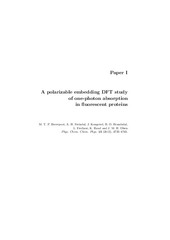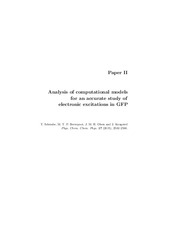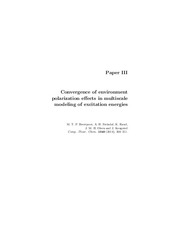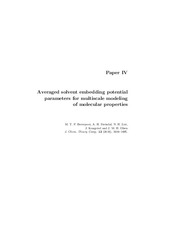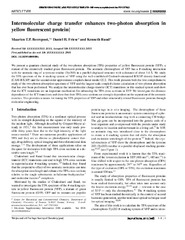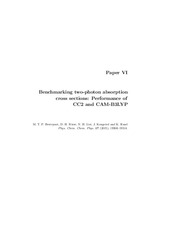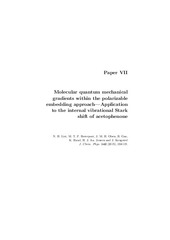| dc.contributor.advisor | Ruud, Kenneth | |
| dc.contributor.author | Beerepoot, Maarten T. P. | |
| dc.date.accessioned | 2016-09-21T11:24:55Z | |
| dc.date.available | 2016-09-21T11:24:55Z | |
| dc.date.issued | 2016-05-13 | |
| dc.description.abstract | This thesis focuses on how absorption properties of molecules are influenced by their environment and how this can be calculated accurately. Calculations have been performed with a polarizable embedding (PE) multiscale model. The environment is described classically by charges and electric multipoles for the permanent electrostatics and polarizabilities for polarization interactions. Density-functional theory (DFT) and approximate singles and doubles coupled-cluster theory (CC2) are used to describe the electronic structure of the molecules. The results indicate that the effects of environmental polarization on electronic and vibrational properties are significant and that the employed PE model is accurate in cases where electrostatic interactions dominate. A large part of the environment needs to be described explicitly for converged molecular properties, especially since polarization interactions range over a long distance. However, accurate embedding parameters for the electrostatic and polarization interactions are important mainly for the closest environment of a chromophore. This enables a reduction of the computational cost of obtaining embedding potentials without sacrificing accuracy. For localized properties, PE is to be preferred over a cluster approach because the latter is severely limited by the possible size of the molecular system. For calculation of two-photon absorption (TPA), DFT and CC2 give qualitatively but not quantitatively similar results. Finally, it is shown that the comparison between calculated TPA cross sections and other experimental or theoretical work is challenging. The presented works contribute to the realistic description of a molecular environment with the accurate prediction of molecular properties in chemical environments as ultimate goal. | en_US |
| dc.description.doctoraltype | ph.d. | en_US |
| dc.description.popularabstract | Beregninger av molekylære egenskaper kan bidra til en bedre forståelse av kjemiske prosesser og er dermed et viktig verktøy som komplementerer eksperimentell kjemi. De molekylære systemene som vi ønsker å beskrive er ofte så store at heller ikke de største datamaskinene har nok regnekraft for å gjøre dette med nøyaktige metoder. Derfor bruker vi flerskalamodeller som kombinerer nøyaktige kvantekjemiske metoder for molekylet med raskere klassiske metoder for omgivelsene. Vi har forsket på hvordan man kan beskrive omgivelsene på en mer nøyaktig måte. Våre metoder har tilstrekkelig nøyaktighet for å forutsi og forklare eksperimentene, men inneholder samtidig noen begrensninger. Vi har avdekket hvordan man kan beskrive omgivelsene på en måte som er både nøyaktig og enkel å bruke. Resultatene bidrar til kunnskap om hvordan vi kan beregne molekylære egenskap nøyaktig og raskt. Dermed kan resultatene bidra til forskning innenfor for eksempel kjemisk katalyse eller utvikling av nye medisiner. | en_US |
| dc.description.sponsorship | European Research Council (Grant 279619)
Research Council of Norway (Grant 179568/V30)
BioStruct, the national graduate school in structural biology (travel grants)
Norwegian Supercomputer Program (Grant NN4654K) | en_US |
| dc.identifier.isbn | 978-82-8236-214-6 (trykt) og 978-82-8236-215-3 (pdf) | |
| dc.identifier.uri | https://hdl.handle.net/10037/9741 | |
| dc.identifier.urn | URN:NBN:no-uit_munin_9215 | |
| dc.language.iso | eng | en_US |
| dc.publisher | UiT Norges arktiske universitet | en_US |
| dc.publisher | UiT The Arctic University of Norway | en_US |
| dc.rights.accessRights | openAccess | |
| dc.rights.holder | Copyright 2016 The Author(s) | |
| dc.subject.courseID | DOKTOR-004 | |
| dc.subject | VDP::Matematikk og Naturvitenskap: 400::Kjemi: 440 | en_US |
| dc.subject | VDP::Mathematics and natural science: 400::Chemistry: 440 | en_US |
| dc.subject | VDP::Matematikk og Naturvitenskap: 400::Kjemi: 440::Teoretisk kjemi, kvantekjemi: 444 | en_US |
| dc.subject | VDP::Mathematics and natural science: 400::Chemistry: 440::Theoretical chemistry, quantum chemistry: 444 | en_US |
| dc.title | Calculating molecular properties in realistic environments | en_US |
| dc.type | Doctoral thesis | en_US |
| dc.type | Doktorgradsavhandling | en_US |


 English
English norsk
norsk
